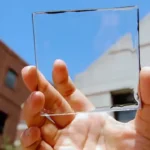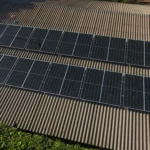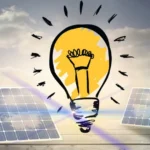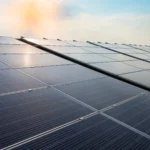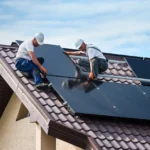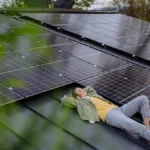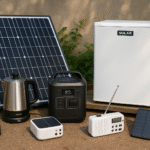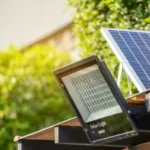Have you ever looked at your solar monitoring app and wondered why your energy output seems to drop even when the sun is out? Or perhaps you’re curious about why solar panels produce one type of electricity, while your home uses another. Understanding the difference between AC vs DC power is key to unlocking better solar efficiency and avoiding common mistakes.
In this guide, you’ll get a straightforward explanation of how AC and DC electricity work in solar systems, why the conversion process matters, and how this knowledge can help you make better decisions as a homeowner, small business owner, or eco-conscious consumer.

What Is the Difference Between AC and DC Power?
At its core, the difference lies in how electricity flows.
- DC (Direct Current) flows in one direction. This is the type of electricity that solar panels produce.
- AC (Alternating Current) changes direction many times per second. This is the electricity that powers your home and appliances.
Solar panels generate DC power when exposed to sunlight. However, homes and the electrical grid run on AC power. This is why an inverter is a crucial part of every solar system. It converts the DC electricity your panels produce into the AC electricity your appliances need.
A Real-World Example
A client of mine in Albuquerque had a 6 kW solar system installed five years ago. Over the past year, their monthly savings dropped despite similar weather conditions. After conducting some diagnostics, we found that their string inverter had degraded and was only converting approximately 89 percent of the DC power to usable AC. A replacement with a more efficient hybrid inverter not only restored performance but also improved battery storage management and app-based monitoring.
Why AC vs DC Power Matters in Your Solar Setup
Most solar system owners don’t think much about the types of electricity, but the distinction affects nearly every component of your setup.
Also Click Here : Jinko solar panels
Inverter Efficiency
Your inverter’s efficiency directly impacts how much solar energy your home can use. Older inverters typically operate around 92 to 95 percent efficiency. Modern models, especially microinverters or hybrid inverters, can achieve efficiencies of up to 98 percent.
That difference can add up. On a sunny day, a 5 kW system might produce 30 kWh of DC power. With a 92 percent efficient inverter, you’d get 27.6 kWh of usable AC. A higher-efficiency inverter could deliver 29.4 kWh. Over a month, that’s a potential gain of nearly 50 kWh.
Compatibility with Solar Batteries
Solar batteries store electricity as DC. If your system isn’t properly configured, converting that energy back and forth between AC and DC can result in additional efficiency losses. That’s why the use of hybrid inverters or battery-ready systems is increasingly popular.
In 2023, over 15 percent of U.S. residential solar installations included battery storage, according to SEIA. Many of these homes benefited from pairing their battery systems with smart hybrid inverters that streamline energy conversion and improve storage performance.
The Impact of Dirty Panels on DC Power Quality
It’s not just shade that reduces output. Dirt, pollen, bird droppings, and even air pollution can degrade solar panel efficiency. This results in reduced DC power generation and, consequently, less AC vs Dc power for your home.
A study from the National Renewable Energy Laboratory (NREL) found that dirty panels can lose anywhere from 7 to 20 percent of their rated output, depending on the local environment. Desert or coastal areas tend to have higher losses.

What You Can Do
- Clean your panels every three to four months, especially during spring pollen season or after heavy winds.
- Avoid abrasive brushes or detergents. Use soft-bristle brushes and deionized water.
- Schedule an annual inspection with your solar installer. They can check for microcracks, soiling buildup, or inverter error codes you might miss.
Charging Your EV: Does AC vs DC Power Matter?
Yes, and significantly.
Most home EV chargers use AC power. Your vehicle then converts that AC into DC to store in its battery. But that internal conversion process isn’t always fast or efficient. This is why DC fast chargers exist—they bypass your vehicle’s onboard charger and supply power directly to the battery.
However, most homes are not equipped for DC fast charging due to its higher power requirements and infrastructure needs. Instead, Level 2 AC chargers remain the go-to for homeowners using solar.
Also Click Here : Canadian solar panels
Making Solar and EV Work Together
If you’re charging your EV from solar, you’re already cycling through AC to DC conversions multiple times. To minimize energy loss:
- Time your charging window to align with peak solar production (usually 10 AM to 2 PM).
- Use a smart inverter with energy management features.
- Consider EV chargers that are compatible with solar energy systems and home storage batteries.
One homeowner in Sacramento shared that after syncing their Level 2 charger to their solar production schedule, they cut their grid dependency for EV charging by nearly 70 percent. That small scheduling change saved them an average of $32 per month.
Off-Grid Systems and the Importance of DC Management
In an off-grid system, you don’t have the safety net of the utility grid. That means managing energy flow becomes far more critical.
DC appliances like LED lights, DC refrigerators, or water pumps—are commonly used in cabins, boats, and off-grid homes because they consume less power. These appliances skip the conversion step entirely and draw directly from the solar battery’s DC output.
For larger off-grid homes, though, AC appliances are usually still necessary. This is where high-efficiency inverters and properly sized batteries come into play.

Design Tips for Off-Grid Living
- Use a hybrid inverter that can support both AC vs DC power loads.
- Size your battery bank to handle 2 to 3 days of cloudy conditions.
- Consider installing a backup generator, especially in colder climates where snow cover can reduce the output of solar panels.
A small off-grid resort I consulted with in northern Wisconsin had initially relied on a pure DC system. As they expanded and added heating, cooking, and water systems, they upgraded to a hybrid AC-DC system. This reduced load management headaches and improved guest experience during peak usage.
Troubleshooting AC vs DC Power Issues
Solar energy systems are usually low-maintenance, but problems can arise. When they do, understanding the flow of AC vs DC power helps diagnose the issue faster.
Common Signs of Conversion Problems
- Sudden drops in solar output on clear days
- Frequent inverter resets or warning lights
- EV chargers are performing inconsistently
- Batteries not reaching full charge
- Flickering lights or appliance surges
What to Check First
- Look at your solar monitoring app. Is panel output consistent with expected weather?
- Inspect your inverter display or portal for error codes.
- Clean the panels if it has been more than three month
- Check system firmware and software updates.
- If problems persist, schedule a technician visit for a full diagnostic.
In my experience, approximately 60 percent of inverter issues are caused by external factors, such as shading, dust, or outdated firmware. The rest are due to equipment wear or poor system design.
Understanding AC vs DC Power Helps You Get the Most from Solar
When you understand how solar panels produce DC power, how it gets converted into AC, and where losses can occur, you’re better prepared to manage your system and catch problems early.
Whether you’re installing a new system, adding a solar battery, or planning to charge an electric vehicle, this knowledge helps you make smarter investments and avoid costly inefficiencies.
It’s not about becoming an engineer. It’s about becoming an informed homeowner.

Schedule a System Performance Checkup
If it’s been over three months since your last panel cleaning or system inspection, you may already be losing up to 20 percent of your system’s output. Schedule a performance checkup today to keep your solar investment working at its best.
FAQs
Q: Can I run my house entirely on DC power?
Technically yes, but it requires rewiring and special appliances. Most homes use AC by default. In off-grid or RV setups, DC can be more practical.
Q: Do I need to replace my inverter when I add a solar battery?
Not always, but many older inverters are not compatible with newer batteries. A hybrid inverter may be needed for efficient DC-to-AC and storage management.
Q: How often should I clean my solar panels?
Typically every 3 to 4 months, depending on your local climate and environment. Dusty or pollen-heavy areas may need more frequent cleaning.
Q: Does DC fast charging harm EV batteries?
Not inherently. However, frequent use of DC fast chargers can generate more heat and stress for some battery chemistries. For daily charging, Level 2 AC charging from solar is more gentle and cost-effective.
Q: What efficiency should I expect from my inverter?
Modern inverters typically run between 96 to 98 percent efficiency. Older models may be as low as 90 to 92 percent, which can lead to noticeable losses over time.


